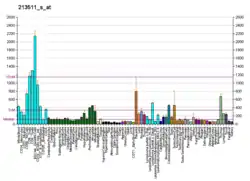MTMR1
Myotubularin-related protein 1 is a protein that in humans is encoded by the MTMR1 gene.[5][6]
This gene encodes a member of the myotubularin related family of proteins. Members of this family contain the consensus sequence for the active site of protein tyrosine phosphatases. Alternatively spliced variants have been described but their biological validity has not been determined.[6]
References
- GRCh38: Ensembl release 89: ENSG00000063601 - Ensembl, May 2017
- GRCm38: Ensembl release 89: ENSMUSG00000015214 - Ensembl, May 2017
- "Human PubMed Reference:". National Center for Biotechnology Information, U.S. National Library of Medicine.
- "Mouse PubMed Reference:". National Center for Biotechnology Information, U.S. National Library of Medicine.
- Kioschis P, Wiemann S, Heiss NS, Francis F, Gotz C, Poustka A, Taudien S, Platzer M, Wiehe T, Beckmann G, Weber J, Nordsiek G, Rosenthal A (Jan 1999). "Genomic organization of a 225-kb region in Xq28 containing the gene for X-linked myotubular myopathy (MTM1) and a related gene (MTMR1)". Genomics. 54 (2): 256–66. doi:10.1006/geno.1998.5560. PMID 9828128.
- "Entrez Gene: MTMR1 myotubularin related protein 1".
Further reading
- Laporte J, Hu LJ, Kretz C, et al. (1996). "A gene mutated in X-linked myotubular myopathy defines a new putative tyrosine phosphatase family conserved in yeast". Nat. Genet. 13 (2): 175–82. doi:10.1038/ng0696-175. PMID 8640223. S2CID 30028223.
- Laporte J, Blondeau F, Buj-Bello A, et al. (1998). "Characterization of the myotubularin dual specificity phosphatase gene family from yeast to human". Hum. Mol. Genet. 7 (11): 1703–12. doi:10.1093/hmg/7.11.1703. PMID 9736772.
- <Please add first missing authors to populate metadata.> (1999). "Toward a complete human genome sequence". Genome Res. 8 (11): 1097–108. doi:10.1101/gr.8.11.1097. PMID 9847074.
- Laporte J, Blondeau F, Buj-Bello A, Mandel JL (2001). "The myotubularin family: from genetic disease to phosphoinositide metabolism". Trends Genet. 17 (4): 221–8. doi:10.1016/S0168-9525(01)02245-4. PMID 11275328.
- Kim SA, Taylor GS, Torgersen KM, Dixon JE (2002). "Myotubularin and MTMR2, phosphatidylinositol 3-phosphatases mutated in myotubular myopathy and type 4B Charcot-Marie-Tooth disease". J. Biol. Chem. 277 (6): 4526–31. doi:10.1074/jbc.M111087200. PMID 11733541.
- Laporte J, Liaubet L, Blondeau F, et al. (2002). "Functional redundancy in the myotubularin family". Biochem. Biophys. Res. Commun. 291 (2): 305–12. doi:10.1006/bbrc.2002.6445. PMID 11846405.
- Buj-Bello A, Furling D, Tronchère H, et al. (2003). "Muscle-specific alternative splicing of myotubularin-related 1 gene is impaired in DM1 muscle cells". Hum. Mol. Genet. 11 (19): 2297–307. doi:10.1093/hmg/11.19.2297. PMID 12217958.
- Strausberg RL, Feingold EA, Grouse LH, et al. (2003). "Generation and initial analysis of more than 15,000 full-length human and mouse cDNA sequences". Proc. Natl. Acad. Sci. U.S.A. 99 (26): 16899–903. Bibcode:2002PNAS...9916899M. doi:10.1073/pnas.242603899. PMC 139241. PMID 12477932.
- Ota T, Suzuki Y, Nishikawa T, et al. (2004). "Complete sequencing and characterization of 21,243 full-length human cDNAs". Nat. Genet. 36 (1): 40–5. doi:10.1038/ng1285. PMID 14702039.
This article is issued from Wikipedia. The text is licensed under Creative Commons - Attribution - Sharealike. Additional terms may apply for the media files.






